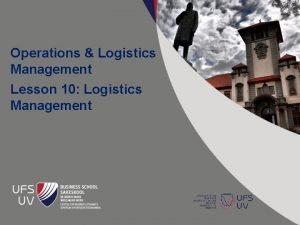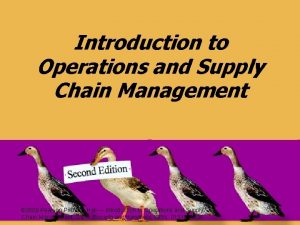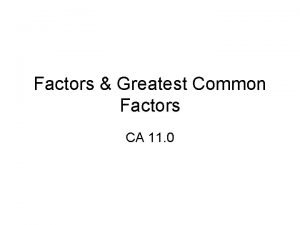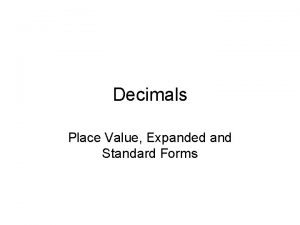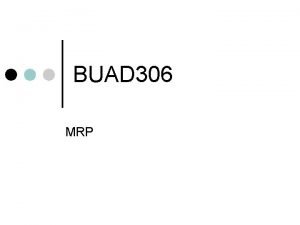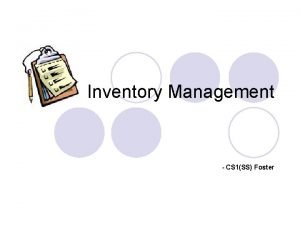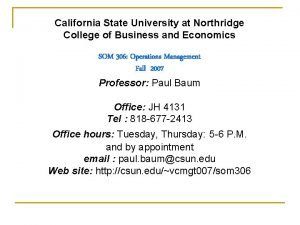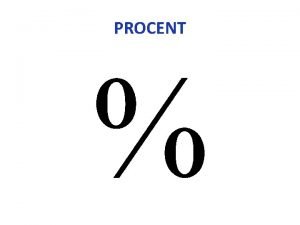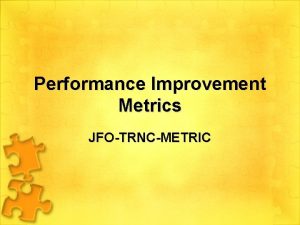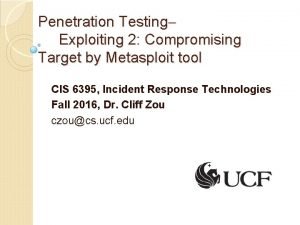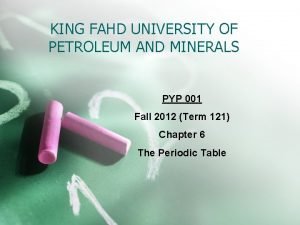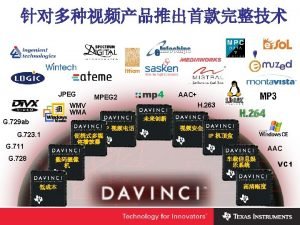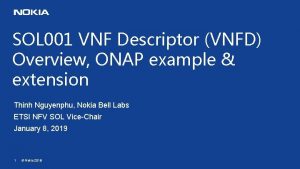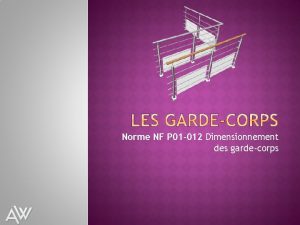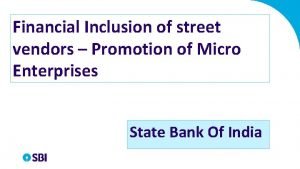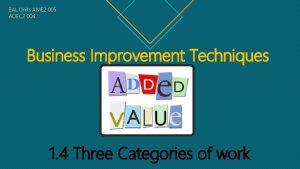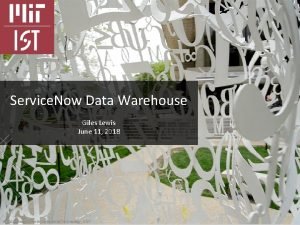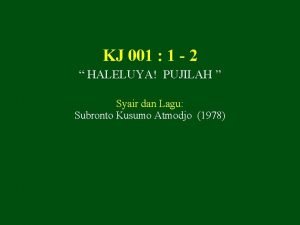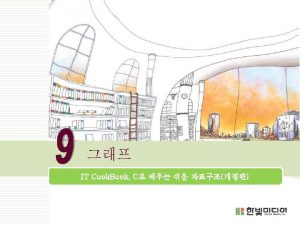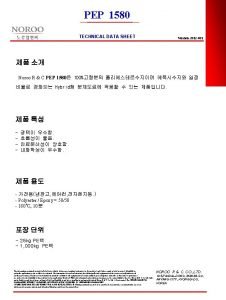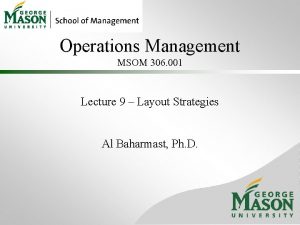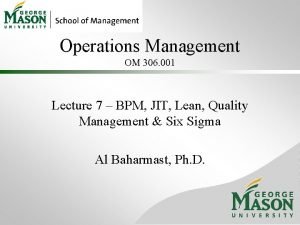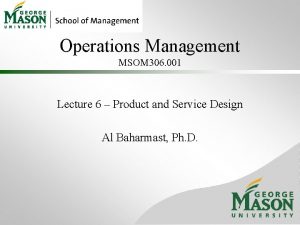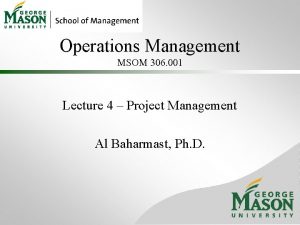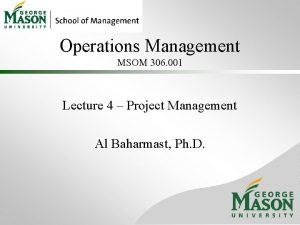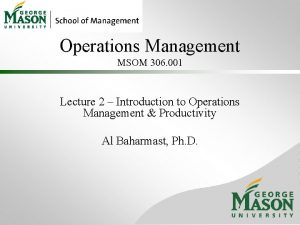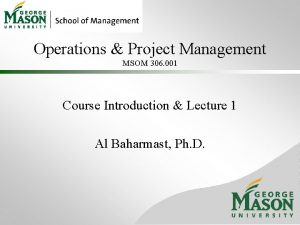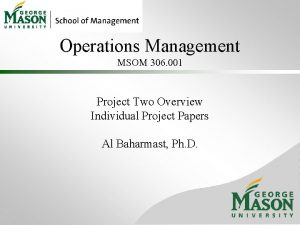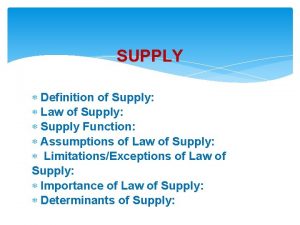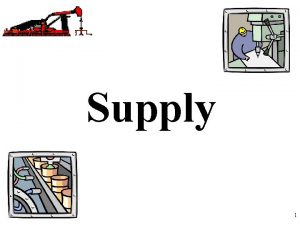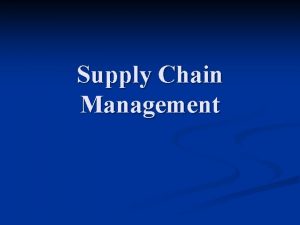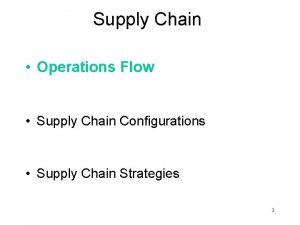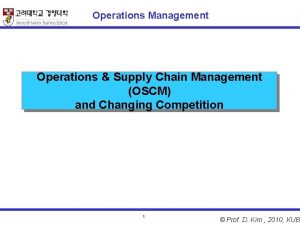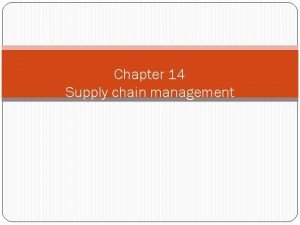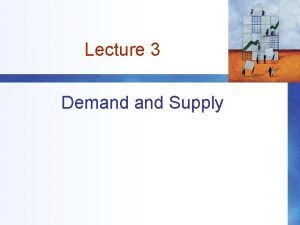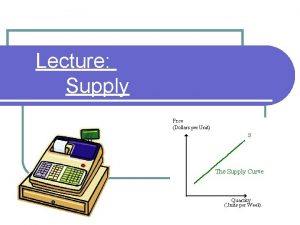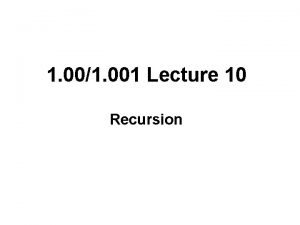Operations Management OM 306 001 Lecture 10 Supply
























































- Slides: 56

Operations Management OM 306. 001 Lecture 10 – Supply Chain Management/E-Commerce Al Baharmast, Ph. D.

The Strategic Importance of the Supply Chain Supply-chain management is the integration of the activities that procure materials and services, transform them into intermediate goods and the final product, and deliver them to customers Competition is no longer between companies; it is between supply chains Some lecture content courtesy of Prentice Hall, Rights Reserved

Supply-Chain Management Important activities include determining 1. Transportation vendors 2. Credit and cash transfers 3. Suppliers 4. Distributors and banks 5. Accounts payable and receivable 6. Warehousing and inventory 7. Order fulfillment 8. Sharing customer, forecasting, and production information Some lecture content courtesy of Prentice Hall, Rights Reserved

Supply Network More reflective of reality – much more complex! e-tailer • Multiple agents across the stages of supply • Multiple channels of distribution (ways of selling a company’s goods) • Multi-directional flows Manufacturer Supplier Consumers Retailer Distributors Manufacturer Consumers Some lecture content courtesy of Prentice Hall, Rights Reserved

Global Supply-Chain Issues Supply chains in a global environment must be able to þ React to sudden changes in parts availability, distribution, or shipping channels, import duties, and currency rates þ Use the latest computer and transmission technologies to schedule and manage the shipment of parts in and finished products out þ Staff with local specialists who handle duties, freight, customs and political issues Some lecture content courtesy of Prentice Hall, Rights Reserved

Supply-Chain Economics Supply Chain Costs as a Percent of Sales Industry All industry Automobile Food % Purchased 52 67 60 Lumber Paper Petroleum Transportation 61 55 79 62 Table 11. 2 Some lecture content courtesy of Prentice Hall, Rights Reserved

Make-or-Buy Decisions Reasons for Making 1. 2. 3. 4. 5. 6. 7. 8. Maintain core competence Lower production cost Unsuitable suppliers Assure adequate supply (quantity or delivery) Utilize surplus labor or facilities Obtain desired quality Remove supplier collusion Obtain unique item that would entail a prohibitive commitment for a supplier 9. Protect personnel from a layoff 10. Protect proprietary design or quality 11. Increase or maintain size of company Table 11. 4 Some lecture content courtesy of Prentice Hall, Rights Reserved

Make-or-Buy Decisions Reasons for Buying 1. Frees management to deal with its primary business 2. Lower acquisition cost 3. Preserve supplier commitment 4. Obtain technical or management ability 5. Inadequate capacity 6. Reduce inventory costs 7. Ensure alternative sources 8. Inadequate managerial or technical resources 9. Reciprocity 10. Item is protected by a patent or trade secret Table 11. 4 Some lecture content courtesy of Prentice Hall, Rights Reserved

Outsourcing þ Transfers traditional internal activities and resources of a firm to outside vendors þ Utilizes the efficiency that comes with specialization þ Firms outsource information technology, accounting, legal, logistics, and production Some lecture content courtesy of Prentice Hall, Rights Reserved

Supply-Chain Strategies þ Negotiating with many suppliers þ Long-term partnering with few suppliers þ Vertical integration þ Keiretsu þ Virtual companies that use suppliers on an as needed basis Some lecture content courtesy of Prentice Hall, Rights Reserved

Many Suppliers þ Commonly used for commodity products þ Purchasing is typically based on price þ Suppliers are pitted against one another þ Supplier is responsible for technology, expertise, forecasting, cost, quality, and delivery Some lecture content courtesy of Prentice Hall, Rights Reserved

Few Suppliers þ Buyer forms longer term relationships with fewer suppliers þ Create value through economies of scale and learning curve improvements þ Suppliers more willing to participate in JIT programs and contribute design and technological expertise þ Cost of changing suppliers is huge Some lecture content courtesy of Prentice Hall, Rights Reserved

Vertical Integration Raw material (suppliers) Examples of Vertical Integration Iron ore Silicon Farming Flour milling Backward integration Steel Current transformation Automobiles Integrated circuits Distribution systems Circuit boards Dealers Computers Watches Calculators Forward integration Finished goods (customers) Baked goods Figure 11. 2 Some lecture content courtesy of Prentice Hall, Rights Reserved

Vertical Integration þ Developing the ability to produce goods or service previously purchased þ Integration may be forward, towards the customer, or backward, towards suppliers þ Can improve cost, quality, and inventory but requires capital, managerial skills, and demand þ Risky in industries with rapid technological change Some lecture content courtesy of Prentice Hall, Rights Reserved

Keiretsu Networks þ A middle ground between few suppliers and vertical integration þ Supplier becomes part of the company coalition þ Often provide financial support for suppliers through ownership or loans þ Members expect long-term relationships and provide technical expertise and stable deliveries þ May extend through several levels of the supply chain Some lecture content courtesy of Prentice Hall, Rights Reserved

Virtual Companies þ Rely on a variety of supplier relationships to provide services on demand þ Fluid organizational boundaries that allow the creation of unique enterprises to meet changing market demands þ Exceptionally lean performance, low capital investment, flexibility, and speed Some lecture content courtesy of Prentice Hall, Rights Reserved

Managing the Supply Chain There are significant management issues in controlling a supply chain involving many independent organizations þ Mutual agreement on goals þ Trust þ Compatible organizational cultures Some lecture content courtesy of Prentice Hall, Rights Reserved

Issues in an Integrated Supply Chain þ Local optimization - focusing on local profit or cost minimization based on limited knowledge þ Incentives (sales incentives, quantity discounts, quotas, and promotions) push merchandise prior to sale þ Large lots - low unit cost but do not reflect sales þ Bullwhip effect - stable demand becomes lumpy orders through the supply chain Some lecture content courtesy of Prentice Hall, Rights Reserved

Why Supply Chain Management is so difficult? • Nonlinearities – 1. Reliance on forecasts at each stage for basing decisions 2. Different demand patterns of different products over time 3. Different constraints (lot-sizing, transport capacity etc. ) 4. Different supply chain structures 5. Dynamic nature of relationships and information • Results into upstream demand amplification (Bull-whip) Courtesy of Partha Datta Martin Christopher & Peter Allen Cranfield University Some lecture content courtesy of Prentice Hall, Rights Reserved

Opportunities in an Integrated Supply Chain þ Accurate “pull” data þ Lot size reduction (or right-sizing) þ Single stage control of replenishment þ Vendor managed inventory þ Postponement Some lecture content courtesy of Prentice Hall, Rights Reserved

Opportunities in an Integrated Supply Chain þ Channel assembly þ Drop shipping and special packaging þ Blanket orders þ Standardization þ Electronic ordering and funds transfer Some lecture content courtesy of Prentice Hall, Rights Reserved

Internet Purchasing Four Common Variations þ Internet used to communicate order releases against blanket purchase orders þ Internet replaces other forms of electronic order releases Some lecture content courtesy of Prentice Hall, Rights Reserved

Internet Purchasing Four Common Variations þ Internet used to buy nonstandard items from catalogs þ Long-term master agreements in place þ Reduces order lead-time and purchasing costs Some lecture content courtesy of Prentice Hall, Rights Reserved

Internet Purchasing Four Common Variations þ Traditional purchasing system, but Internet-based þ Significantly speeds up requisitioning, bidding, supplier selection, and order placement Some lecture content courtesy of Prentice Hall, Rights Reserved

Internet Purchasing Four Common Variations þ Internet auctions þ May be used for commodity items for which long-term contracts do not exist Some lecture content courtesy of Prentice Hall, Rights Reserved

Internet Purchasing Individual initiates requisition Purchasing department/buyer Prepares requisition Buyer reviews requisition Inputs request into computer system and transmits to purchasing department Enters data into Internet system Assigns suppliers to bid; gives closing dates and conditions Supplier Receives electronic purchase order Ships good; receives electronic payment Collects/reviews bids submitted electronically Selects a supplier based on quality, cost, delivery performance; issues purchase order Some lecture content courtesy of Prentice Hall, Rights Reserved Figure 11. 3

Internet Purchasing þ Suppliers get closer to their customers þ Shorter cycle times may improve cash flow þ Capital investment is low þ Buyers enjoy comparison shopping, rapid ordering, reduced transaction costs, and lower inventory þ May be part of an integrated Enterprise Resource Planning (ERP) system Some lecture content courtesy of Prentice Hall, Rights Reserved

Vendor Selection þ Vendor evaluation þ Critical decision þ Find potential vendors þ Determine the likelihood of them becoming good suppliers þ Vendor Development þ Training þ Engineering and production help þ Establish policies and procedures Some lecture content courtesy of Prentice Hall, Rights Reserved

Vendor Selection þ Negotiations þ Cost-Based Price Model - supplier opens books to purchaser þ Market-Based Price Model - price based on published, auction, or indexed price þ Competitive Bidding - used for infrequent purchases but may make establishing long-term relationships difficult Some lecture content courtesy of Prentice Hall, Rights Reserved

Vendor Evaluation Criteria Weights Engineering/research/innovation skills . 20 5 1. 0 Production process capability (flexibility/technical assistance) . 15 4 . 6 Distribution/delivery capability . 05 4 . 2 Quality systems and performance . 10 2 . 2 Facilities/location . 05 2 . 1 Financial and managerial strength (stability and cost structure) . 15 4 . 6 Information systems capability (ecommerce, Internet) . 10 2 . 2 Integrity (environmental compliance/ ethics) . 20 5 1. 0 Total 1. 00 Some lecture content courtesy of Prentice Hall, Rights Reserved Scores (1 -5) Weight x Score 3. 9

Distribution Systems þ Trucking þ Moves the vast majority of manufactured goods þ Chief advantage is flexibility þ Railroads þ Capable of carrying large loads þ Little flexibility though containers and piggybacking have helped with this Some lecture content courtesy of Prentice Hall, Rights Reserved

Distribution Systems þ Airfreight þ Fast and flexible for light loads þ May be expensive þ Waterways þ Typically used for bulky, lowvalue cargo þ Used when shipping cost is more important than speed Some lecture content courtesy of Prentice Hall, Rights Reserved

Distribution Systems þ Pipelines þ Used for transporting oil, gas, and other chemical products Some lecture content courtesy of Prentice Hall, Rights Reserved

Cost of Shipping Alternatives þ Product in transit is a form of inventory and has a carrying cost þ Faster shipping is generally more expensive than slower shipping þ We can evaluate the two costs to better understand the trade-off Some lecture content courtesy of Prentice Hall, Rights Reserved

Electronic Commerce þ E-commerce (or e-business) – the use of the internet to buy and sell products and services and exchange information þ Low cost rapid exchanges þ A whole new way of doing business “… all about cycle time, speed, globalization, enhanced productivity, reaching new customers and sharing knowledge across institutions for competitive advantage. ” Louis Gerstner Former Chairman, IBM Some lecture content courtesy of Prentice Hall, Rights Reserved

E-Commerce Definitions þ Business-to-business (B 2 B) – Both sides of the transaction are businesses, nonprofit organizations, or governments þ Business-to-consumer (B 2 C) – Transactions in which buyers are individual consumers þ Consumer-to-consumer (C 2 C) – Consumers sell directly to each other þ Consumer-to-business (C 2 B) – Individuals sell services or goods to businesses Some lecture content courtesy of Prentice Hall, Rights Reserved

Economics of E-Commerce þ Costs of information exchange are dramatically reduced þ Barriers to entry are lower þ Time constraints almost disappear þ Information and communication is cheap and easy Some lecture content courtesy of Prentice Hall, Rights Reserved

Product Design þ Easily shared knowledge and information allows quicker and lower cost design cycles that can involve participants in diverse locations þ Product data can be managed over the Internet þ Engineering changes and configuration management can be extended along the supply chain Some lecture content courtesy of Prentice Hall, Rights Reserved

Collaborative Project Management þ Project management software allows for establishing intranet sites for sharing documents and maintaining status reports þ Intranets can also be used for document libraries Some lecture content courtesy of Prentice Hall, Rights Reserved

E-Procurement Purchasing or order release communicated over the Internet Online catalogs allow quicker cost comparisons and bidding processes Catalogs can be provided by þ Vendors þ Intermediaries þ Buyers Some lecture content courtesy of Prentice Hall, Rights Reserved

Online Catalogs þ Vendor catalogs provide quick and easy access to the entire product line þ Available to anyone with Internet access þ Quick and easy to customize and adjust þ Reduced paper trails reduce purchasing costs Some lecture content courtesy of Prentice Hall, Rights Reserved

Internet Trading Exchanges Retail goods — setup by Sears and France’s Carrefour; called Global. Net. Xchange for retailers (gnx. com) Health care products — set up by Johnson & Johnson, GE Medical systems, Baxter International, Abbott Laboratories, and Medtronic Inc; called the Global Heath Care Exchange (ghx. com) Table S 11. 3 Some lecture content courtesy of Prentice Hall, Rights Reserved

Internet Trading Exchanges Defense and aerospace products — created by Boeing, Raytheon, Lockheed-Martin, and Britain’s BAE Systems; called the Aerospace and Defense Industry Trading Exchange (exostar. com) Food, beverage, consumer products — set up by 49 leading food and beverage firms; called Transora (transora. com) Table S 11. 3 Some lecture content courtesy of Prentice Hall, Rights Reserved

Internet Trading Exchanges Steel and metal products — such as New View Technologies (exchange. e-steel. com); and Metal-Site (metalsite. com) Hotels — created by Marriott and Hyatt, and later joined by Fairmont, Six Continents, and Club Corp: called Aventra (aventra. com) buys for 2, 800 hotels Table S 11. 3 Some lecture content courtesy of Prentice Hall, Rights Reserved

E-Procurement þ Online Auctions þ Maintained by buyers (reverse), sellers (forward), or intermediaries þ May be used to sell excess raw material or discontinued or excess inventory þ Low cost and increased access to buyers Some lecture content courtesy of Prentice Hall, Rights Reserved

Seller’s (Forward) Auctions - Traditionally, auctions were seller-initiated events – means of getting a highest price - A seller identifies a single product or a lot that they intend to sell - Often requires an intermediary – an auctioneer/qualifier - Generally, the highest bidder (English auction) or the first high bidder (Dutch auction) ‘wins’ - B-2 -B seller auctions are most viable for - Commoditized goods (wheat, cattle, steel) - Consortium-controlled goods (oil, flowers) Some lecture content courtesy of Prentice Hall, Rights Reserved

Buyer’s (Reverse) Auctions - Relatively new, very successful for B-2 -B buy environments – means of getting the lowest price - A buyer identifies a single product or a lot that they intend to buy - Often requires an intermediary – an auctioneer/qualifier - Generally, the lowest bidder (English auction) or the first low bidder (Dutch auction) ‘wins’ - B-2 -B buyer auctions are most viable for - Standardized product acquisitions - Simple services with broadly applicable performance criteria Some lecture content courtesy of Prentice Hall, Rights Reserved

Introduction to SCOR • Supply Chain Council – A leading inter-industry organization consisting of about 1000 top international firms including manufacturers, services, distributors, and retailers. • SCOR – The Supply Chain Council’s “Supply Chain Operations Reference Model” From the Supply Chain Council’s SCOR Version 7. 0 Overview Some lecture content courtesy of Prentice Hall, Rights Reserved

Introduction to SCOR A Process Reference Model Contains: • • • Standard descriptions of management processes A framework of relationships among the standard processes Standard metrics to measure process performance Management practices that produce best-in-class performance Standard alignment to features and functionality From the Supply Chain Council’s SCOR Version 7. 0 Overview Some lecture content courtesy of Prentice Hall, Rights Reserved

Introduction to SCOR • SCOR spans: • All customer interactions, from order entry through paid invoice • All product (physical material and service) transactions, from your supplier’s supplier to your customer’s customer, including equipment, supplies, spare parts, bulk product, software, etc. • All market interactions, from the understanding of aggregate demand to the fulfillment of each order • SCOR does not attempt to describe every business process or activity, including: • • Sales and marketing (demand generation) Research and technology development Product development Some elements of post-delivery customer support From the Supply Chain Council’s SCOR Version 7. 0 Overview Some lecture content courtesy of Prentice Hall, Rights Reserved

Introduction to SCOR • Demand/Supply Planning and Management • Balance resources with requirements and establish/communicate plans for the whole supply chain, including Return, and the execution processes of Source, Make, and Deliver. • Management of business rules, supply chain performance, data collection, inventory, capital assets, transportation, planning configuration, and regulatory requirements and compliance. • Align the supply chain unit plan with the financial plan. Note- Planning is required in aggregate and for other, detailed processes PLAN From the Supply Chain Council’s SCOR Version 7. 0 Overview Some lecture content courtesy of Prentice Hall, Rights Reserved

Introduction to SCOR • Sourcing Stocked, Make-to-Order, and Engineer -to-Order Product • Schedule deliveries; receive, verify, and transfer product; and authorize supplier payments. • Identify and select supply sources when not predetermined, as for engineer-to-order product. • Manage business rules, assess supplier performance, and maintain data. • Manage inventory, capital assets, incoming product, supplier network, import/export requirements, and supplier agreements. SOURCE From the Supply Chain Council’s SCOR Version 7. 0 Overview Some lecture content courtesy of Prentice Hall, Rights Reserved

Introduction to SCOR • Make-to-Stock, Make-to-Order, and Engineer-to -Order Production Execution • Schedule production activities, issue product, produce and test, package, stage product, and release product to deliver. • Finalize engineering for engineer-to-order product. • Manage rules, performance, data, in-process products (WIP), equipment and facilities, transportation, production network, and regulatory compliance for production. MAKE From the Supply Chain Council’s SCOR Version 7. 0 Overview Some lecture content courtesy of Prentice Hall, Rights Reserved

Introduction to SCOR • Order, Warehouse, Transportation, and Installation Management for Stocked, Make-to-Order, and Engineer-to-Order Product • All order management steps from processing customer inquiries and quotes to routing shipments and selecting carriers. • Warehouse management from receiving and picking product to load and ship product. • Receive and verify product at customer site and install, if necessary. • Invoicing customer. • Manage Deliver business rules, performance, information, finished product inventories, capital assets, transportation, product life cycle, and import/export requirements. DELIVER From the Supply Chain Council’s SCOR Version 7. 0 Overview Some lecture content courtesy of Prentice Hall, Rights Reserved

Introduction to SCOR • Return of Raw Materials and Receipt of Returns of Finished Goods • All Return Defective Product steps from source – identify product condition, disposition product, request product return authorization, schedule product shipment, and return defective product – and deliver – authorized product return, schedule return receipt, receive product, and transfer defective product. • All Return of Maintenance, Repair, and Overhaul product steps from source – identify product condition, disposition product, request product return authorization, schedule product shipment, and return MRO product – and deliver – authorize product return, schedule return receipt, receive product, and transfer MRO product. • All Return Excess Product steps from source – identify product condition, disposition product, request product return authorization, schedule product shipment, and return excess product – and deliver – authorize product return, schedule return receipt, receive product, and transfer excess product. • Manage Return business rules, performance, data collection, return inventory, capital assets, transportation, network configuration, and regulatory requirements and compliance. RETURN From the Supply Chain Council’s SCOR Version 7. 0 Overview Some lecture content courtesy of Prentice Hall, Rights Reserved

Introduction to SCOR Level Name Top Level (Process Types) Description ØDefines the scope and content for the Supply Chain Operations Reference-model. Basis of competition performance targets are set. Configuration Level (Process Categories) ØConfiguration from 30 core “process categories. ” Companies implement their operations strategy through the supply chain configuration they choose. Process Element Level (Decompose Processes) ØDefines a company’s ability to compete successfully in its chosen markets, and consists of: Process element definitions, Process element information inputs, and outputs, Process performance metrics, Best practices, where applicable, System capabilities required to support best practices, and Systems/tools; Companies “fine tune” their Operations Strategy at Level 3. Implementation Level (Decompose Process Elements) ØCompanies implement specific supply-chain management practices at this level. Level 4 defines practices to achieve competitive advantage and to adapt to changing business conditions. From the Supply Chain Council’s SCOR Version 7. 0 Overview Some lecture content courtesy of Prentice Hall, Rights Reserved
 Operations management lecture notes doc
Operations management lecture notes doc Introduction to operations and supply chain management
Introduction to operations and supply chain management Introduction to operations and supply chain management
Introduction to operations and supply chain management 01:640:244 lecture notes - lecture 15: plat, idah, farad
01:640:244 lecture notes - lecture 15: plat, idah, farad National general benefits solutions providers
National general benefits solutions providers Gcf of 25 and 30
Gcf of 25 and 30 Ecologist
Ecologist Troop 306 avon
Troop 306 avon Ed 306
Ed 306 Virtudes teologales
Virtudes teologales Calomel electrode
Calomel electrode Paulo cesar sentelhas
Paulo cesar sentelhas Meteorologia cesar
Meteorologia cesar Paulo sentelhas e angelocci geadas aula lce 306
Paulo sentelhas e angelocci geadas aula lce 306 306
306 306 in expanded form
306 in expanded form 306
306 Product structure tree example
Product structure tree example Buad 306
Buad 306 306 bones
306 bones Navsup form 306
Navsup form 306 Som 306 csun
Som 306 csun Switch mode power supply lecture notes
Switch mode power supply lecture notes Quality management in operations management
Quality management in operations management Chapter 12 inventory management
Chapter 12 inventory management Operations management with total quality management book
Operations management with total quality management book Heterojenleşme nedir
Heterojenleşme nedir How to find the critical values
How to find the critical values 25 ppm i procent
25 ppm i procent Acad 02-001
Acad 02-001 Vsftpd metasploit
Vsftpd metasploit Nom 001 stps 2008 edificios locales e instalaciones
Nom 001 stps 2008 edificios locales e instalaciones Multiplicação por 0 1 0 01 e 0 001
Multiplicação por 0 1 0 01 e 0 001 Cpt 99374
Cpt 99374 85 dag ile to kg
85 dag ile to kg Pyp-001
Pyp-001 60m height
60m height 011 101 001
011 101 001 Dm6443-001
Dm6443-001 Vnfd
Vnfd Semt.001
Semt.001 Write 702 001 in expanded form
Write 702 001 in expanded form Norme nfp01-012
Norme nfp01-012 Easa cm-swceh-001
Easa cm-swceh-001 In mudra loan rs.50 001 to rs.500 000 are categorised as
In mudra loan rs.50 001 to rs.500 000 are categorised as Auec2-004
Auec2-004 Ip-eng-001
Ip-eng-001 How many significant figures are in 3,000,001
How many significant figures are in 3,000,001 Servicenow demo 001
Servicenow demo 001 Syair jebret
Syair jebret Pyp-001
Pyp-001 001 002 003
001 002 003 Ices-001 issue 5
Ices-001 issue 5 Aml 001
Aml 001 Pep-001
Pep-001 Hai kristen nyanyilah lirik
Hai kristen nyanyilah lirik 100000x0.005
100000x0.005

